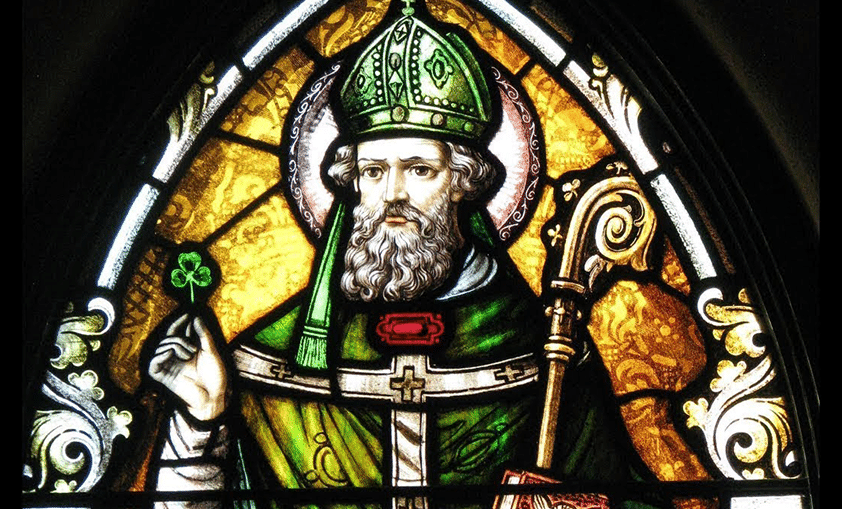Saint Patrick is celebrated today in America and elsewhere with a flurry of green decorations, shamrocks, and probably some partying.
As Catholics, hopefully we’re not falling into the trap of using this saint’s feast day just as an excuse for excessive drinking. But merely avoiding this pitfall is still falling short of making this holiday all it could be for us.
The exact reasoning of why the color green is associated with St. Patrick is complicated and somewhat up for debate. But his use of the shamrock to help explain the Blessed Trinity is at least part of the reason.
St. Patrick’s Trinitarian theology alone makes him an interesting saint for us to power through the secularization and focus on in a spiritual way.
But even more pertinent to us, especially those us of who are at a point of uncertainty in any areas of our life, is St. Patrick’s trust in God.
Here’s a bit of background about this ever-popular Irish saint whose trust in God was so great that he feared nothing.
An early life lacking faith

Patrick was not actually born in Ireland. He was born in the year 387, in an area of Great Britain that was under the governance of the Roman Empire. His exact birthplace isn’t known for certain.
He was raised in a Christian household and his father was a deacon. But Patrick himself did not have a strong faith during his early life at home.
When Patrick was in his mid-teens, some Irish pirates captured him during a raiding party. They enslaved him, and he was taken to Ireland to tend sheep.
St. Patrick’s deeper conversion

Ireland at that time was full of pagans and Druids. Ironically, it was Patrick’s time spent as a captive in this pagan land that led to his deeper conversion.
In his memoir, The Confession, he wrote that this time he spent in slavery was incredibly important for his spiritual development. There, God had mercy on him and gave him the opportunity to repent of his earlier sins.
While working as a shepherd in captivity, he spent a lot of time in prayer. He wrote in his memoir about this time:
“The love of God and His fear grew in me more and more, as did the faith, and my soul was raised, so that, in a single day, I have said as many as a hundred prayers and in the night, nearly the same. I prayed in the woods and on the mountain, even before dawn. I felt no hurt from the snow or ice or rain.”
St. Patrick’s return home

Patrick’s captivity in Ireland as a slave lasted until he was twenty years old, when he was able to escape.
He had a dream in which God told him to leave Ireland by fleeing to the coast. Patrick did this, traveling two hundred miles to a port, where he found sailors. They were reluctant to allow him onto their ship, but he was able to persuade the captain to take him in.
The journey back was not a simple one, as the ship landed three days later in what seems to have been an unplanned stop. Patrick and the others walked through a wilderness for twenty-eight days and neared starvation.
Patrick prayed that they would be given food, and he encouraged the others to put their faith in God.
Not long after, they came upon a herd of wild boar and were able to eat.
Patrick eventually arrived all the way back at his home. A few years later, he had a vision of a man from Ireland. The people of Ireland seemed to be crying out to him.
The vision inspired Patrick to study for the priesthood. He was soon ordained a priest, and not long after he was ordained a bishop.
A return to Ireland

As a bishop, Patrick was sent back to Ireland, the land of his captivity. He was to preach there among the Druids as a missionary.
He arrived in Slane, Ireland, in 433. Once there, he immediately got to work preaching, but he was not welcome.
One tradition says that a Druid chieftain tried to kill him, but that through in intervention from God the chieftain converted. Then, Patrick was able to preach freely throughout the country.
Through Patrick’s work, many Irish people were converted. He baptized thousands of people and he ordained many new priests to assist him in his work. In some instances, entire kingdoms converted after hearing him preach.
The shamrock we associate with Patrick today was said to have been part of his preaching, as he used the three-leaf clover to help explain the doctrine of the Blessed Trinity.
Patrick worked preaching the Gospel in Ireland for forty years. He worked many miracles and endured a lot of suffering throughout his years of work there.
On one occasion, he was beaten and robbed. He was kept in chains for sixty days, possibly waiting to be executed. But his account of the incident gives few further details.
A deep trust in God

There are many other legends about the life and work of Patrick in Ireland whose authenticity can’t be verified. But we do know that this saint had a deep trust in God throughout his life.
It is said that he trusted in God and in the mission God had called him to so very deeply that he did not fear anything, even death.
Patrick has left us a poem called “The Breastplate” about his faith and trust in God:
“Christ be within me, Christ behind me, Christ before me, Christ beside me, Christ to win me, Christ to comfort and restore me, Christ beneath me, Christ above me, Christ inquired, Christ in danger, Christ in hearts of all that love me, Christ in mouth of friend and stranger.”
As we celebrate St. Patrick’s Day this year, let us focus on growing in the kind of faith and trust that St. Patrick practiced in his life.
St. Patrick, pray for us!



